Few things captivate the senses as profoundly as the mesmerizing dance of flames and the tantalizing aromas of live fire cooking.
“Live fire cooking involves all five senses—as all cooking does—but even more so than most cooking," says Todd Annis with Cru Catering (Charleston, SC). “The smell of the smoke and fat burning over it, hearing the crackle of the wood, the sight of the flame and even the low embers slightly illuminating the fish or meat [are so enticing]. [Then there is] the feel of the heat near you and on the item that is being cooked, and lastly the taste and how you get that crispy crunchy char outside and the flavor and juices from the inside.”
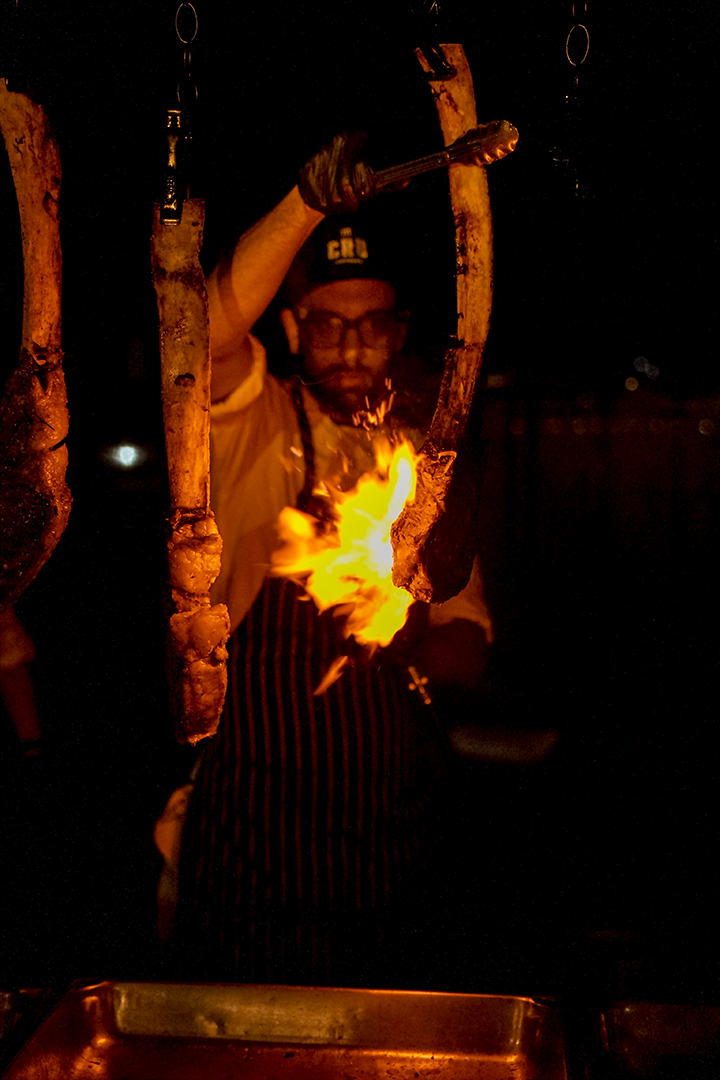
For a tomahawk steak carving station during a recent event, Cru Catering (Charleston, SC) first seasoned the steaks, put them in a 250-degree oven for about 45 minutes until the internal temperature was 10 degrees under their end goal (about 120-125 degrees). For the sear, Cru Catering torched each side (with the Grill Blazer Su-VGun) of the steak for about a minute (in front of guests) to get the nice crust on the outside and finish the cooking process. The steaks then rested before being carved for guests right on station. Photo courtesy Cru Catering
“The sizzle, the aromatic smoke, the changing color of the meat—all these provide a visual experience that is as tantalizing as the taste of the food itself,” adds Rich Rosendale with Rosendale Events (Atlanta, GA).
“Live fire cooking” refers to the method of cooking food over embers—wood or charcoal—that encompasses a variety of different techniques (grilling, smoking, roasting, etc.).
“I believe being able to manipulate fire and coals to produce a stunning meal is an art form in its own right,” says Patrick McCandless with Rambler Events (Nashville, TN).
Embracing the primal element
From ancient civilizations to modern-day gastronomy, cooking over an open flame has been an integral part of human culture.
“Cooking with fire is, of course, the oldest cooking method in the world, and was the only method of cooking for many thousands of years,” says McCandless. “It is fascinating to see how it has evolved over time.”
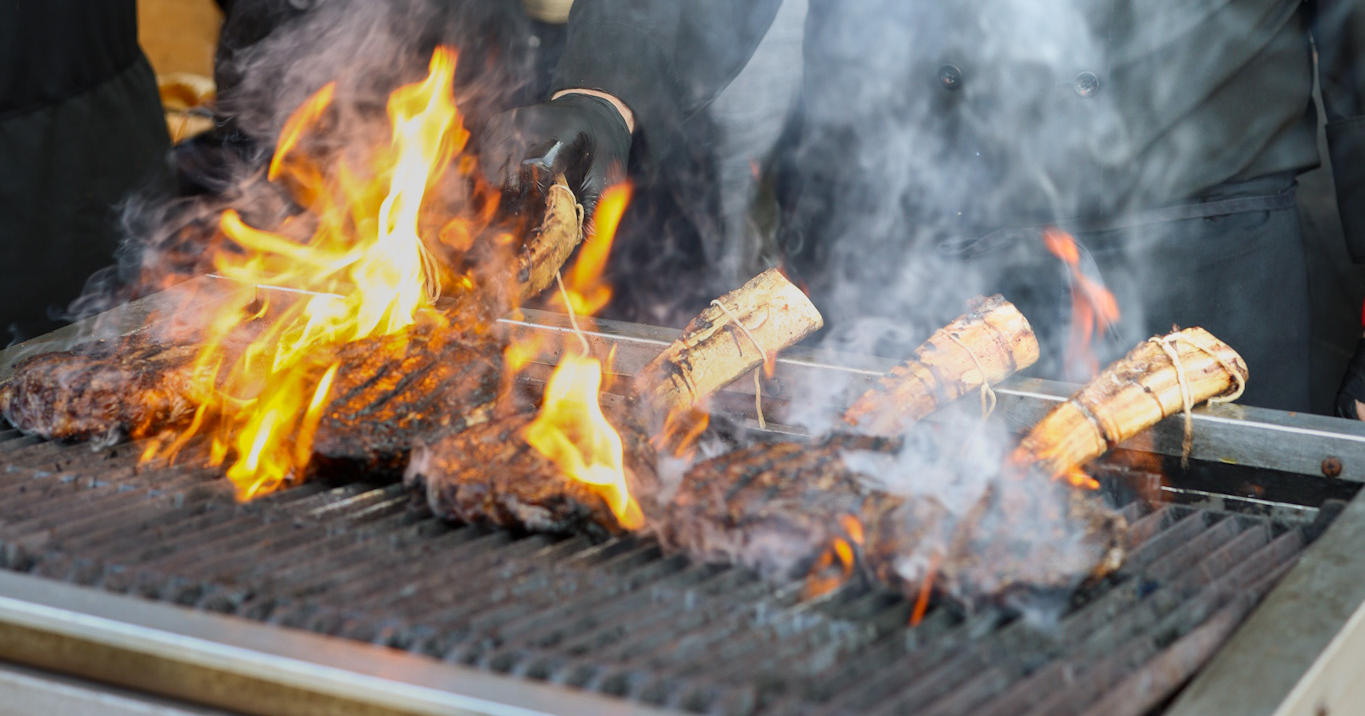
Puff ‘n Stuff Events & Catering (Orlando, FL) prepared a tomahawk steak (via live fire cooking) during the Art of Catering Food visit to its Orlando catering facility. Photo courtesy WASIO Faces/SpotMyPhotos
A few examples from around the world include roasting whole pig or lamb as seen in Greek Orthodox or Hawaiian traditions, Hmong fire cooking, using tagines in Morocco, Spanish paella, baking bread in earthen ovens, wood-fired pizza ovens in Italy, and campfires. Making a fire doesn’t necessarily mean you have to grill meat either—some Laotian cooking involves heating a pot of water over the fire for noodle soup with fresh greens and sprouts.
“I think at a basic level, human beings are tied to fire, and it’s in our DNA,” says James Gop with Heirloom Fire (Richmond, MA). “I believe that the moment that we learned how to harness the power of fire to cook was the moment we became civilized.”
Live fire cooking embraces this primal element, infusing each dish with unique flavors and an undeniable sense of authenticity. Whether it’s a crackling bonfire, a wood-fired oven, or a sizzling grill, the allure of live fire brings a touch of nostalgia and excitement to any event.
“We are always drawn to its rustic appeal and roots; there is something naturally romantic about it,” says Chef Sean Holden with Puff ‘n Stuff Events & Catering (Orlando, FL). “It’s comfort and nourishment in its purest form. Sharing a fire and a meal with one another to me, at its core, is pure and the most natural way to connect and build relationships.”
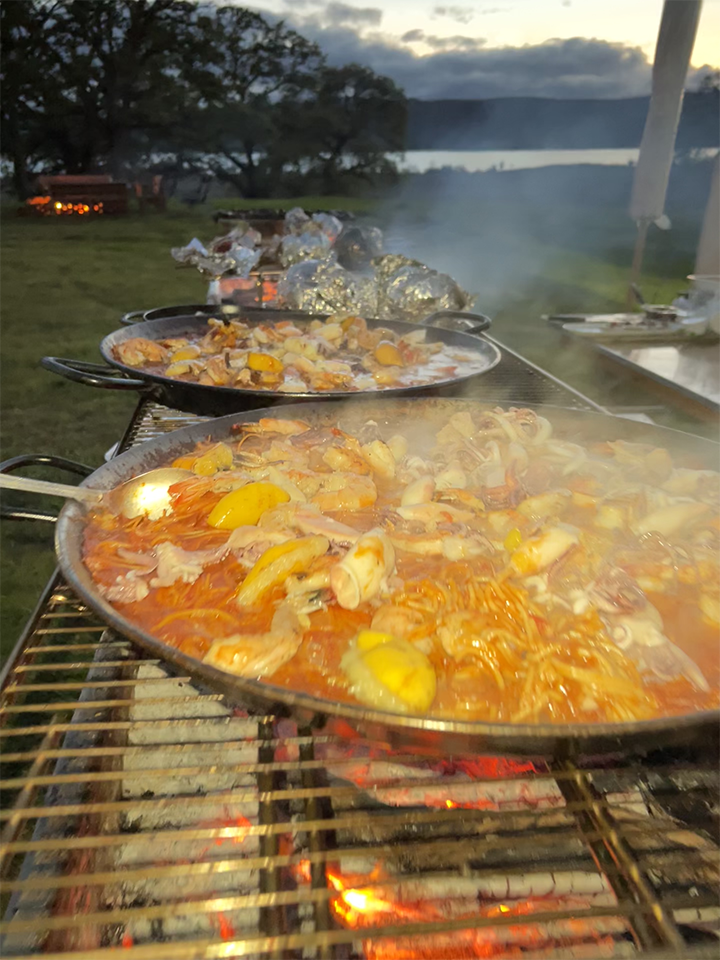
During a glamping-inspired event, Chef Alex Espinoza with Bottega (Napa, CA) did his take on a paella (over an open fire) with steak, lamb, and pasta. Photo courtesy Barilla
“It may be a trend now, but for some it’s been a way of life,” adds Jason Hernandez with Blade and Tine Culinary Consulting. “We are not creating anything new here, this style has been around for centuries. There may be more light shone on it now as a trend, but look through history and this was a way of life and a way to survive, this was not a way to get followers. People may have changed over time but the way of cooking with fire has not.”
The smoke show
Live fire cooking encompasses a range of techniques, each adding its own distinct character to the dishes (Check out the Barbecue Bible for some of the most popular techniques).
“You can essentially do everything that you do in an indoor kitchen outdoors, with a bit more skill and finesse,” says Gop. “You can dig a trench, fill it with coals so they cook in the earth. You can hang a piece of protein above a fire, so it never comes in direct contact, but cooks nice and slow with radiant heat. You can cook something on a spit directly over the flames. You can use large cauldrons and cook grain or braised items around the fire. You can utilize salt as a crust on top of proteins or vegetables that allows them to steam inside of a hard shell.”
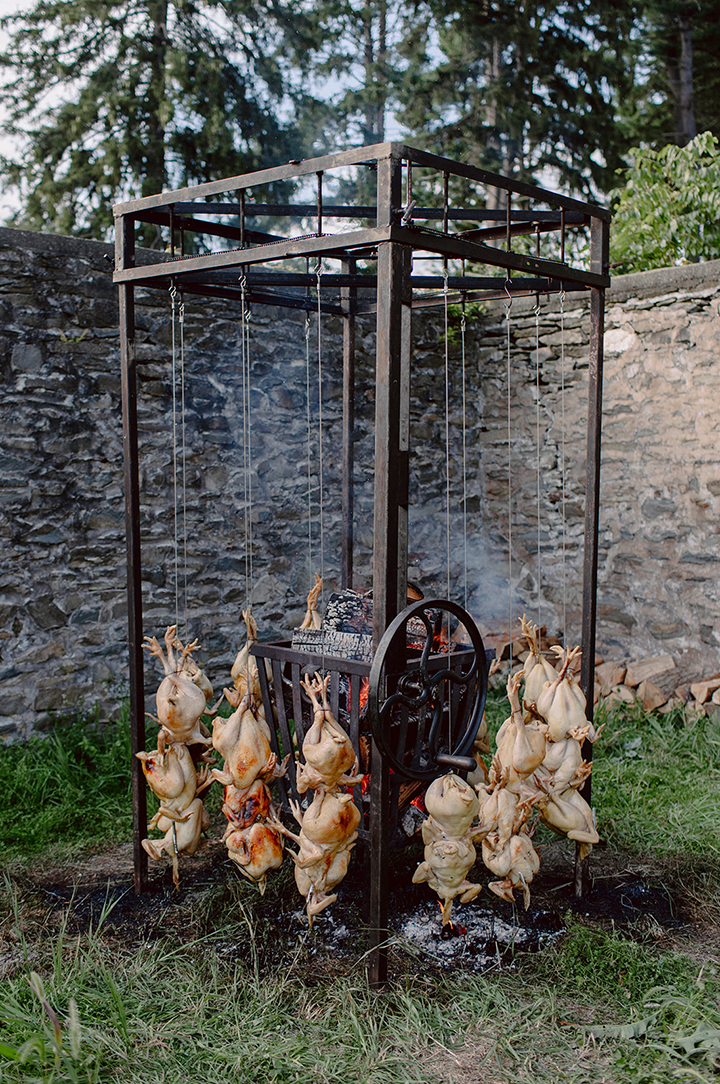
Heirloom Fire (Richmond, MA) is a sustainably minded, fire-based catering events company located deep in the Berkshire Hills of Western Massachusetts. Shown: Heirloom Fire roasting whole chickens around the hearth basket. Photo courtesy Logan Smith
While some chefs swear by whole logs or woodchips (e.g., hickory, cherry, oak, mesquite, apple, and peach), others rely on charcoal (e.g., binchotan, mesquite, tractional wood, and eucalyptus). Whichever fuel is used depends on each chef’s individual preference.
“The type of fuel you choose will significantly affect the flavor of your food,” Rosendale says. “For example, fruit woods like apple and cherry impart a milder, sweeter smoke flavor ideal for chicken or fish, while hickory and oak provide a stronger, hearty flavor perfect for beef or pork.”
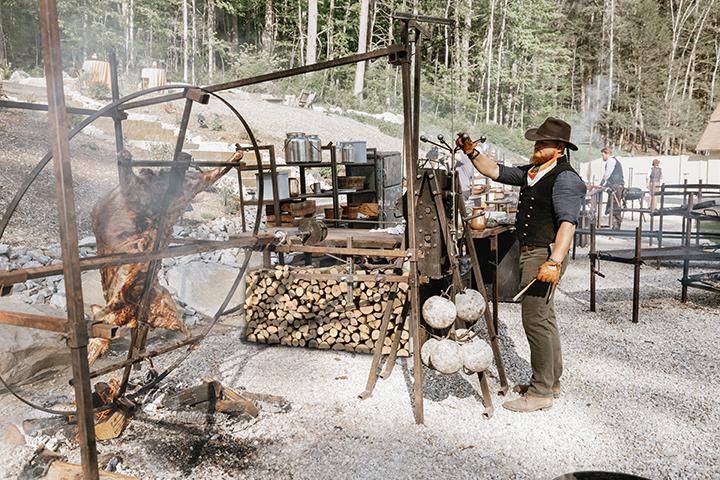
Heirloom Fire prepares a whole lamb during an event. Photo courtesy Dear Edith and Lily
“Certainly, there are countless combinations to achieve based on what we’re looking for,” adds Holden, “and the only way to get there is to literally play with fire.”
One thing to note: live fire cooking isn’t about the fire itself, but rather the smoke.
“There is way more to live fire cooking than many people expect,” says Annis. “The ‘smoke’ is an actual ingredient, so you have to choose your wood carefully. When you have that smell of sweet potatoes or onions on the fire or the char of a nice New York Strip with the fat dripping into the flame, it literally sends the smoke signal out.”
Live fire cooking is not just a feast for the palate either, but it can also be a captivating visual spectacle.
“Incorporating live action to any event allows the guests to interact with the experience, taking it to a level where fire is involved and awakens the senses,” says Holden. “Rather than sitting at a table and having a beautiful plate brought to you, a guest can see, smell, hear, and watch the creation get built right before them, immersing them in the finished dish.”
“What we do is much more than just cooking food, it’s a performance,” Gop adds. “Since people can see everything that we do, there is a certain energy that is emitted. It’s essentially like going to see live music versus a DJ. You just feel it.”

An example of how Rambler Events (Nashville, TN) sets up their field kitchen during live fire cooking events. Photo courtesy Kaitlin Mendoza
While culinary theatrics add an unforgettable element to live fire cooking events, it’s essential to strike the right balance. The focus should remain on the quality of the food and the culinary experience, with theatrics enhancing the overall ambiance rather than overshadowing it.
“Open fire always will have the best results when ingredients are handled properly,” says Holden.
“Going back to the idea that we eat with our eyes first, it’s important to have some showstoppers but it’s also important that the food tastes incredible, so you have to put thought into both aspects,” adds Gop.
Setting the stage
No matter how experienced a caterer is, there are a few things to be aware of up front when preparing food via live fire cooking. Let’s detail some of the dos and don’ts (broken down between set up, preparation, and clean up).
The spark
Live fire cooking requires quite a bit of equipment, but the specific equipment depends on each chef’s or caterer’s desired outcomes.
“It really depends on what you are cooking for and what you’re trying to accomplish,” McCandless explains. “At the most basic level of live-fire cooking, you just need the fire itself.”
A Step-by-Step Guide for Live Fire Cooking
- Arrange the logs: Stack the logs into a square shape like they’re Lincoln Logs, keeping the center of the shape open. Place some hardwood charcoal and clumps of paper and cardboard in the center, making sure there’s enough room for air flow.
- Light the charcoal: Light the charcoal in the center, which will catch on fire easily and get red hot until it starts burning the wood around it.
- Wait about 30 minutes until embers form: This is a good time to prep the food you’re putting on the grill. You know the embers have formed when the wood and charcoal are covered in white ashes. Another test is to hold your hand 10 inches away from the embers. If you can only keep it there for a few seconds, the setup is ready for cooking.
- Create heat zones with the embers: With your tongs, bank the embers up to one side of the live fire grill to create a hot side, warm side and cool side.
- Add the food: You want to add the meat when the embers are at their hottest. Smaller cuts of meat cook quickly over the hot side of the grill, while larger ones, such as a whole chicken, might start on direct heat and finish over indirect heat. Vegetables should be placed on the medium heat area where they’ll cook low and slow.
- Control the fire, don't let it control you: Don't be afraid of the fire. You can control how quickly everything is cooking with a few techniques.
Information above courtesy the Food Network and Chef Yia Vang
Standard equipment for live fire cooking includes wood fire and charcoal grills, torches, pots and pans, grates, spits, cassette burners, propane, smoker boxes, thermometers, skewers, cutting boards, broilers, and tongs.
“You want to make sure that you have all of the same things that you would use in a kitchen,” Hernandez says.
While there’s obviously a lot of standard equipment that is available for purchase, many caterers design their own custom equipment to better meet their needs.
“I’ve always been the type of person that will admire a specific kind of design or technique but then wonder how we can make it our own,” says Gop.
Also, don’t forget your safety equipment such as fire extinguishers, aprons, safety glasses, and heat resistant gloves.
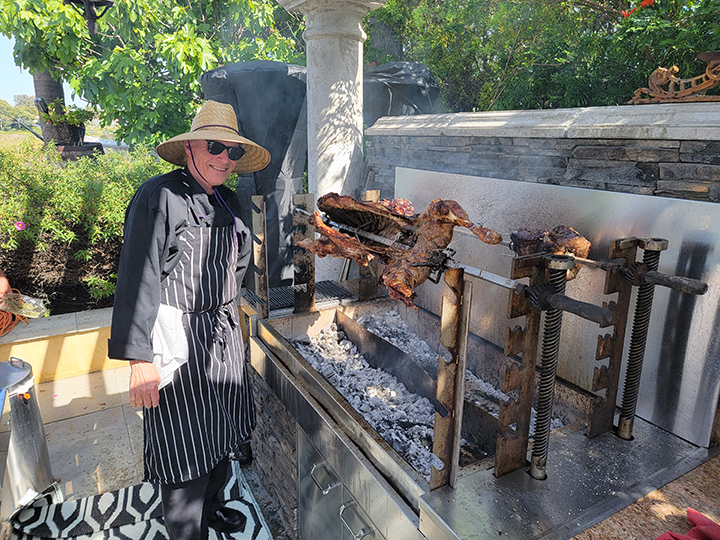
Roy Porter (Engage Works, Inc.) prepared a whole lamb through live fire cooking as part of a Greek Orthodox Easter celebration. Photo courtesy Roy Porter
Once the equipment list is set, it’s time to load up and transport everything to the event.
“Transport for equipment and food is the root of catering,” says Holden. “Culinary works in conjunction with warehousing and together formulate a list of required items, safety precautions, execution points, and storage.”
Upon arrival at the event venue, it’s time to build the field kitchen. On average, most caterers will set up their equipment a day prior at maximum, or four to five hours in advance at minimum.
“We take as much time designing our kitchen for our onsite events as we do preparing our food,” says Gop. “It’s essentially our stage.”
Taming the flames
There are different philosophies for cooking food onsite using live fire cooking. Some caterers will prepare everything onsite, which obviously requires considerable prep time, while others will pre-cook a lot of their menu items and only use the live fire setup for the final flourish.
“Timing is everything, having the grill set and ready, knowing what you are cooking and how it will be cooked, and what estimated time to serve all come into account,” Hernandez says. “Creating heat zones is critical when live fire cooking; you have a zone for meats, a zone for fish, a zone for the tender veggies, and a zone for seafood. Being able to understand the heat and the products that you are using really makes a difference.”
Cooking over an open flame requires constant care and attention given that active flames can oftentimes be unpredictable.
“Fire is an amazing element that you never control fully, it’s a constant negotiation and you work with it,” says Gop.
“I mark certain milestones, so I know when these items have to be on the fire,” he continues. “Once they’re on the fire, it still requires constant maintenance, because the wind direction and speed can change constantly, so it’s a constant dance.”
“You are now a meteorologist,” adds Hernandez. “The thing to remember is that this cooking method takes time. This is not a slap a burger on the grill and its ready in five minutes. Time, patience, and understanding of what you are cooking makes the difference.”
However, given the unpredictability of fire and cooking outdoors, this is where a caterer’s creativity comes into play.
“Here’s where experience and instinct play a massive part,” says Rosendale. “You have to learn to judge the fire’s heat and adjust the food’s position accordingly. It’s also vital to manage your fire and add fuel when necessary to maintain the required temperature.”
The cool down
At the end of the event, caterers will need to extinguish the coals, break down and clean the cooking equipment, deconstruct the mobile kitchen, and load everything back into its place in the truck.
“Clean up can make or break your company,” says Gop. “After a 15-hour day we have to break down all of the gear that we set up earlier in the day and clean up the space to make it look like we were never there.”
“It’s a bit dirty with all of the smoke, ash, and charcoal,” adds Hernandez, “and it really sticks to you.”

Heirloom Fire’s Communal Table Board getting its final touches. Photo courtesy James Gop
At the end of the day, whether or not a live fire cooking event is successful comes down to how prepared and organized the caterer is.
“You have to really be passionate about this and want to do it, or it will wear you down quickly,” says McCandless.
“Be very organized and give yourself over to the technique. It’s going to be uncomfortable because you’re not used to it; and try not to use an indoor oven as a crutch. If you’re going to do it and represent the culture, do it the whole way,” adds Gop. “At the end of the day, you’re either a good planner or you’re not, and you also have to understand that we are all in this together.”
So, are you up to the challenge of live fire cooking?
“Grilling over fire, it’s an experience,” said James Beard nominated Chef Yia Vang (and 2023 Art of Catering Food keynote) during the Food Network’s Stoked television series. “You have to make a lot of mistakes. Once you are able to have an understanding and a flow of it and you’re not fearful of the flames anymore, it becomes very fun. There’s something very beautiful about cooking over fire.”



